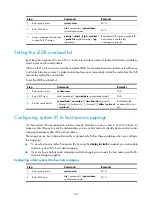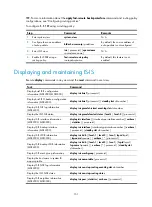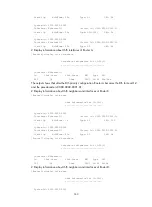
145
Step Command
Remarks
3.
Configure a system ID to host
name mapping for a remote
IS.
is-name map
sys-id
map-sys-name
A system ID can correspond to only
one host name.
Configuring dynamic system ID to host name mapping
Static system ID to host name mapping requires you to manually configure a mapping for each router in
the network. When a new router is added to the network or a mapping must be modified, you must
configure all routers manually.
When you use dynamic system ID to host name mapping, you only need to configure a host name for
each router in the network. Each router advertises the host name in a dynamic host name CLV to other
routers so all routers in the network can have all mappings.
To help check the origin of LSPs in the LSDB, you can configure a name for the DIS in a broadcast
network.
To configure dynamic system ID to host name mapping:
Step Command
Remarks
1.
Enter system view.
system-view
N/A
2.
Enter IS-IS view.
isis
[
process-id
] [
vpn-instance
vpn-instance-name
]
N/A
3.
Specify a host name
for the IS and enable
dynamic system ID to
host name mapping.
is-name
sys-name
By default, no host name is specified for
the router.
4.
Return to system view.
quit
N/A
5.
Enter interface view.
interface
interface-type
interface-number
N/A
6.
Configure a DIS name.
isis dis-name
symbolic-name
By default, no DIS name is configured.
This command takes effect only on a
router enabled with dynamic system ID to
host name mapping.
This command is not available on P2P
interfaces.
Enabling the logging of neighbor state changes
With this feature enabled, the router delivers logs about neighbor state changes to its information center.
The information center processes the logs according to user-defined output rules (whether to output logs
and where to output). For more information about the information center, see
Network Management and
Monitoring Configuration Guide
.
To enable the logging of neighbor state changes:
Step Command
Remarks
1.
Enter system view.
system-view
N/A
















































